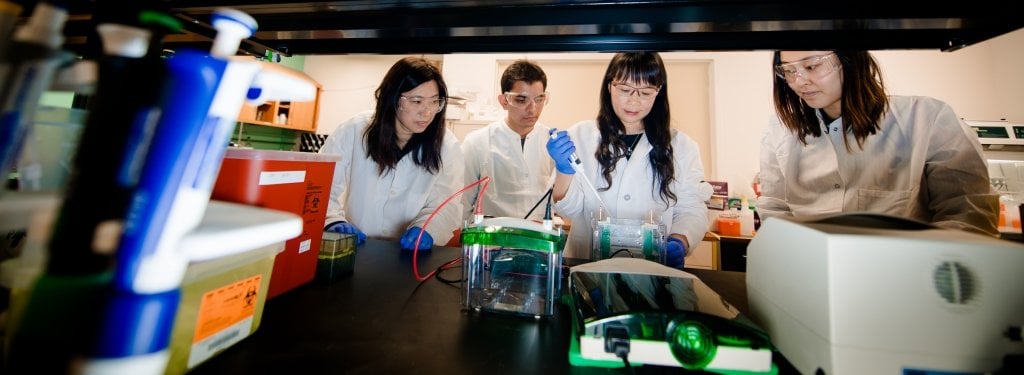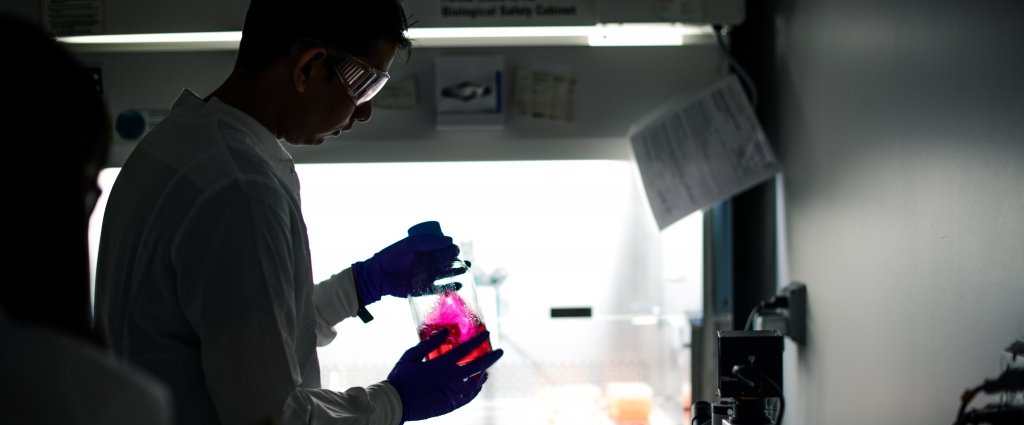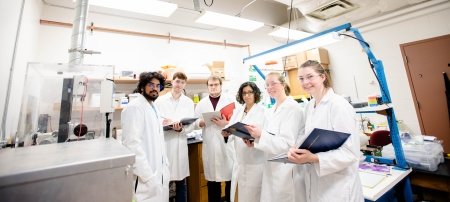Feng Zhao and Zichen Qian have won the 2018 Bhakta Rath Research Award for their work on nanoscaffolding in tissue engineering.
Beneath the skin, the human body is a vast network of arteries, veins and capillaries that transport nutrients and oxygen to cells. If these connections are damaged, the body tries to repair itself. When this fails, tissue engineering can offer hope for restoration.
At Michigan Tech, two researchers have been awarded the Bhakta Rath Award, Michigan Tech’s top honor to a doctoral student and faculty advisor working on cutting edge research that has important social implications. Zichen Qian ‘17 and Feng Zhao, associate professor of biomedical engineering, have been working on how to provide enough oxygen to implanted tissues so they don’t die and the body doesn’t reject a tissue implant.
Vascularizing tissue implants—providing a way for implants to quickly form connections with existing tissues—is the goal toward which Qian and Zhao are working.
Just breathe: Engineering pre-vascularized tissues to encourage lower implantation rejection rates
Qian and Zhao’s work differs from that of others because rather than using synthetic material to create implant prototypes, the pair creates tissues by using actual cells. Using multi-potent adult stem cells, which can differentiate into a few different cell types, including cartilage, skeletal and muscle, there is less risk that the cells will morph the tissue implant into a malignant tumor, which is more likely to occur with pluripotent stem cells. Additionally, by using a person’s own cells to make engineered tissue, the body is more likely to accept the implant, known as a low-immune response.

However, engineering tissue isn’t analogous to patching a tire—some tissues, such as cardiac and skeletal muscles, must be highly aligned to millions of microvessels and must be a certain density, or thickness, which aids in maturation of blood vessels and the functional performance of the engineered tissue.
Qian and Zhao use cells from human skin to make a material of highly aligned nanofibers by using a patterned substrate on top of which cells secrete proteins and sugars to organize into nanofibers.
After removing the substrate, the aligned nanofibers remain.
“We call that the scaffold,” Zhao said. “It’s elastic and flexible. On top of the scaffold, we grow stem cells.”
By attaining the same physiological oxygen concentration in the scaffold as the location where the stem cells are obtained from the body, Zhao and Qian are able to maintain a high plasticity to the stem cells while evading problematic cell differentiation.
On top of the aligned scaffold grow the cells that form the capillaries—endothelial cells—the tube-like inner layer of the blood vessels, contributing to the highly aligned nature of the engineered capillaries. The stem cells help to stabilize the micro-vessels and mature them.
The duo’s next step is to build on their scaffolding approach to make thick, dense tissues.
Mentoring and a collaborative environment are the key to engineering success
But even such revolutionary research isn’t the entire focus of the Bhakta Rath Award. An equally important aspect is the relationship between adviser and student. Zhao spoke fondly of the working relationship she had with Qian, describing their weekly meetings as sessions of discovery, discussing the science and planning for future research. She also described the bond between two immigrants who have had to work through language barriers while reaching expectations of excellence.

“Feng always inspires me with new ideas and guides me to improve my new experiment designs,” Qian says. “She shares her perspective on the feasibility of potential solutions, helps me prioritize my efforts to stay focused and encourages me to dig deeper on new findings.”
And Zhao’s comment on how Qian operates may strike hope into the hearts of overworked graduate students everywhere: “He’s not the kind of person who works seven days a week, but he works wisely. He’s diligent and efficient. Research takes time to learn and to do.”
Qian graduated from Michigan Tech in 2017 and now works as a scientist at Merck developing engineered cell lines for manufacturing therapeutic biologics. He and Zhao have co-authored 14 publications, four of which Qian was first author. Moreover, they currently have one more paper under review, which they say is their best yet.
“My PhD training on cell biology and engineering is critical for my day-to-day job now,” Qian says. “I’m grateful about all the knowledge and skills that I acquired earlier to help me do better in the future.”
Michigan Technological University is an R1 public research university founded in 1885 in Houghton, and is home to nearly 7,500 students from more than 60 countries around the world. Consistently ranked among the best universities in the country for return on investment, Michigan's flagship technological university offers more than 120 undergraduate and graduate degree programs in science and technology, engineering, computing, forestry, business, health professions, humanities, mathematics, social sciences, and the arts. The rural campus is situated just miles from Lake Superior in Michigan's Upper Peninsula, offering year-round opportunities for outdoor adventure.






Comments